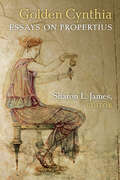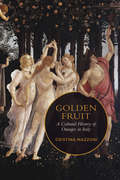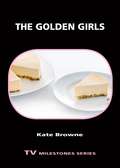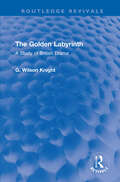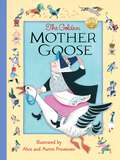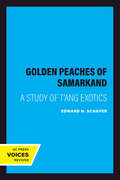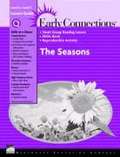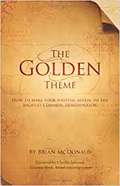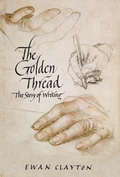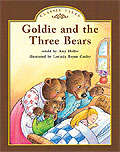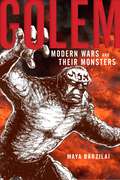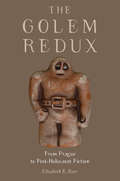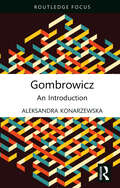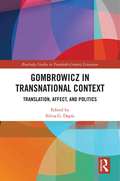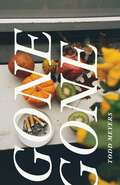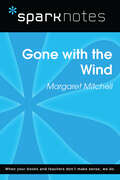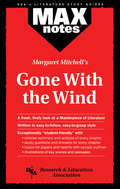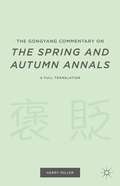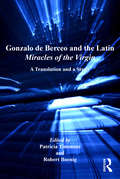- Table View
- List View
Golden Codgers: Biographical Speculations
by Richard EllmannA historical survey of the literary biography, looking at the founding fathers of literary thought.
Golden Cynthia: Essays on Propertius
by Sharon L JamesThe elegiac poet Propertius responds in his verse to the complex changes that Rome underwent in his period, taking on numerous topics including poetic and sexual rivalry, visual art, violence, inability to control the elusive mistress, imperialism, colonialism, civil war, the radical new shape of the Roman state under the new monarch Augustus, and more. These essays, by well-known scholars of Roman elegy, offer new ways of reading Propertius’ topics, attitudes, and poetics. This book begins with two distinguished essays by the late Barbara Flaschenriem, whose work on Propertius remains influential. The other contributions, offered in honor of her, are by Diane Rayor, Andrew Feldherr, Ellen Greene, Lowell Bowditch, Alison Keith, and volume editor Sharon L. James. These essays explore topics including Propertian didacticism, dream interpretation, visual art and formalism, sex and violence, Roman imperialism and its connection to the elegiac puella, and Propertius’ engagement, in Book 4, with Vergil’s poetry.
Golden Fruit: A Cultural History of Oranges in Italy (Toronto Italian Studies)
by Christina MazzoniThrough a close reading of key texts, including poetic and spiritual writings, fairy tales, and a botanical treatise, Golden Fruit examines the role of oranges in Italian culture from their introduction during the medieval period through to the present day. Featuring a beautiful full-colour spread, Cristina Mazzoni’s book brings together artistic depictions, literary analysis, historical context, and popular culture to investigate the changing representations of the orange over time and across the Italian peninsula. Oranges were introduced to Italy in the 1200s, many centuries after beloved Mediterranean fruits such as grapes, figs, and pomegranates—all well-known since Antiquity. Not burdened with age-old meanings and symbolism, then, oranges in early modern times provided a malleable image for artists, writers, and scientists alike. Thus, in the Middle Ages and Renaissance, oranges appear in visual and verbal representations as an effective aid in physical and spiritual health, as symbols of romantic and of divine love, and as signs of geographic allegiance to one’s citrus-rich land. Baroque poets, botanists, and painters regularly compared oranges to women for their shared hybrid nature, whereas later folklore presented this dual character of oranges from an economic standpoint, as both precious and dangerous. The violence intrinsic to oranges in these Sicilian texts from the eighteen and nineteen hundreds returns in the controversial representations of the orange harvest in early twenty-first century Italy.
The Golden Girls (TV Milestones Series)
by Kate BrowneThe Golden Girls made its prime-time debut in 1985 on NBC, and the critically acclaimed show has been a constant television companion through cable reruns and streaming media services ever since. Most people know that The Golden Girls is a sitcom about four feisty, older women living together in Miami who love to eat cheesecake, but Kate Browne argues that The Golden Girls is about so much more. Drawing on feminist literary studies and television studies, Browne makes a case for The Golden Girls as a TV milestone not only because it remains one of the most popular sitcoms in television history but also because its characters reflect shifting complexities of gender, age, and economic status for women in the late twentieth century and beyond. Each chapter is dedicated to exploring what makes these remarkable characters defy expectations of how older women should look, act, and love. Chapter 1 focuses on Dorothy Zbornak’s intriguing gender performance and shifting desirability. Chapter 2 digs into Blanche Devereux’s difficult relationship with motherhood and aging. Chapter 3 highlights how Rose Nylund made all the "right" choices in life but consistently finds herself disenfranchised by the same social and economic institutions that promised to protect her at midlife. Chapter 4 centers on how Sophia Petrillo drives the action of the show as a trickster—bending plots to her own desires and offering moral lessons to the other characters. The book offers an important analysis of a hugely popular sitcom that extends the boundary of what makes TV groundbreaking and worthy of study. Browne argues that The Golden Girls is a "classic" sitcom in almost every way, which keeps audiences engaged and allows the show to make subversive moves when it matters most. Written with both superfans and scholars in mind, the book invites new, diverse ways of thinking about the show to spark future scholarship and conversation about four of the most beloved characters in sitcom history.
The Golden Labyrinth: A Study of British Drama (Routledge Revivals)
by G. Wilson KnightFirst published in 1965, The Golden Labyrinth provides a coherent and readable history of the essential nature of British drama in a single volume. The treatment is philosophical and imaginative, and full of enthusiasm and clarity which have made Professor Wilson Knight’s works, of Shakespearian and other interpretations, so famous. The chapters in this book have been organized according to literary periods and will appeal to both students of literature and casual readers.
The Golden Mother Goose
by Alice Provensen Martin ProvensenA Golden classic, proudly reissued in celebration of the 75th anniversary of Golden Books! Every home needs a book of Mother Goose rhymes! They&’re a child&’s introduction to poetry and a love of language. This Golden Books edition, originally published in 1948, features over a hundred lively rhymes and splendid illustrations by Caldecott Medalists Alice and Martin Provensen. The original artwork has been digitally restored for this edition—resulting in a stunning, best-ever reproduction! It makes a beautiful gift for a beloved child, sure to be read again and again.
The Golden Peaches of Samarkand: A Study of T'ang Exotics
by Edward H. SchaferIn the seventh century the kingdom of Samarkand sent formal gifts of fancy yellow peaches, large as goose eggs and with a color like gold, to the Chinese court at Ch'ang-an. What kind of fruit these golden peaches really were cannot now be guessed, but they have the glamour of mystery, and they symbolize all the exotic things longed for, and unknown things hoped for, by the people of the T'ang empire.This book examines the exotics imported into China during the T'ang Dynasty (A.D. 618-907), and depicts their influence on Chinese life. Into the land during the three centuries of T'ang came the natives of almost every nation of Asia, all bringing exotic wares either as gifts or as goods to be sold. Ivory, rare woods, drugs, diamonds, magicians, dancing girls—the author covers all classes of unusual imports, their places of origin, their lore, their effort on costume, dwellings, diet, and on painting, sculpture, music, and poetry.This book is not a statistical record of commercial imports and medieval trade, but rather a "humanistic essay, however material its subject matter."
Golden Shield: MTC NEXTSTAGE ORIGINAL
by Anchuli Felicia KingTenacious young lawyer Julie Chen brings her sister Eva on board as a translator in a risky legal battle with international ramifications. Leading a class action exposing an American tech giant's involvement with the Chinese government's internet firewall, Golden Shield, they must put their differences aside to confront censorship, mass surveillance, corporate greed and their own complicated past. Loyalty, family and language are tested in this Melbourne Theatre Company NEXT STAGE Original production. Commissioned through MTC's NEXT STAGE Writers' Program with the support of the Playwrights Giving Circle Donors, The Ian Potter Foundation, Naomi Milgrom Foundation, The Myer Foundation, Malcolm Robertson Foundation and The University of Melbourne.
The Golden Spike
by Stephen Cosgrove Kitty Higgins Pam Hirschfeld Jackie UrbanovicPerform this script about the linking of the Union Pacific Railroad and the Central Pacific Railroad to form the Transcontinental Railroad.
The Golden Theme: How to Make Your Writing Appeal to the Highest Common Denominator
by Brian McDonaldAt the heart of every great work is an essential commonality, which author and teacher Brian McDonald explores in The Golden Theme. McDonald's previous book, Invisible Ink, has been acclaimed by award winning authors and screenwriters. In The Golden Theme he turns to the question of what makes writing and storytelling essential to us. Readers and writers will benefit from his deep insight. "Brian McDonald is one of the world's wisest teachers of the elements that create great storytelling....If you a writer in any genre, read The Golden Theme. If you are a non-writing reader who just loves stories, read it. If you are a teacher, share it with your students. And give it to friends, who will thank you for the clarity Brian McDonald so generously brings to our lives." - from the Foreword by National Book Award winner Charles Johnson.
The Golden Thread: The Story of Writing
by Ewan ClaytonFrom the simple representative shapes used to record transactions of goods and services in ancient Mesopotamia, to the sophisticated typographical resources available to the twenty-first-century users of desktop computers, the story of writing is the story of human civilization itself.Calligraphy expert Ewan Clayton traces the history of an invention which-ever since our ancestors made the transition from a nomadic to an agrarian way of life in the eighth century BC-has been the method of codification and dissemination of ideas in every field of human endeavour, and a motor of cultural, scientific and political progress. He explores the social and cultural impact of, among other stages, the invention of the alphabet; the replacement of the papyrus scroll with the codex in the late Roman period; the perfecting of printing using moveable type in the fifteenth century and the ensuing spread of literacy; the industrialization of printing during the Industrial Revolution; the impact of artistic Modernism on the written word in the early twentieth century-and of the digital switchover at the century's close. The Golden Thread also raises issues of urgent interest for a society living in an era of unprecedented change to the tools and technologies of written communication. Chief among these is the fundamental question: "What does it mean to be literate in the early twenty-first century?" The book belongs on the bookshelves of anyone who is inquisitive not just about the centrality of writing in the history of humanity, but also about its future; it is sure to appeal to lovers of language, books and cultural history.
Goldie and the Three Bears (Fountas & Pinnell LLI Green #Level G, Lesson 71)
by Amy HelferFountas and Pinnell Leveled Literacy Intervention Green System -- 1st Grade
Golem: Modern Wars and Their Monsters
by Maya Barzilai2017 Jordan Schnitzer Book Award in Jewish Literature and LinguisticsHonorable Mention, 2016 Baron Book Prize presented by AAJRA monster tour of the Golem narrative across various cultural and historical landscapesIn the 1910s and 1920s, a “golem cult” swept across Europe and the U.S., later surfacing in Israel. Why did this story of a powerful clay monster molded and animated by a rabbi to protect his community become so popular and pervasive? The golem has appeared in a remarkable range of popular media: from the Yiddish theater to American comic books, from German silent film to Quentin Tarantino movies. This book showcases how the golem was remolded, throughout the war-torn twentieth century, as a muscular protector, injured combatant, and even murderous avenger. This evolution of the golem narrative is made comprehensible by, and also helps us to better understand, one of the defining aspects of the last one hundred years: mass warfare and its ancillary technologies.In the twentieth century the golem became a figure of war. It represented the chaos of warfare, the automation of war technologies, and the devastation wrought upon soldiers’ bodies and psyches. Golem: Modern Wars and Their Monsters draws on some of the most popular and significant renditions of this story in order to unravel the paradoxical coincidence of wartime destruction and the fantasy of artificial creation. Due to its aggressive and rebellious sides, the golem became a means for reflection about how technological progress has altered human lives, as well as an avenue for experimentation with the media and art forms capable of expressing the monstrosity of war.
The Golem Redux: From Prague to Post-Holocaust Fiction
by Elizabeth R. BaerTraces the history of the golem legend and its appropriations in German texts and film as well as in post-Holocaust Jewish-American fiction, comics, graphic novels, and television.
Gomant Bharati Konkani class 4 - Goa Board: गोमंत भारती कोंकणी यत्ता चवथी - गोवा बोर्ड
by Shikshan Sanchanalay Panaji Goa Sarkar"गोमंत भारती - कोंकणी, चवथी इयत्ता" हे पुस्तक गोव्यातील प्राथमिक शाळांतील विद्यार्थ्यांसाठी तयार करण्यात आले असून, त्यातून भाषा शिक्षणाबरोबरच गोव्याच्या सांस्कृतिक, ऐतिहासिक आणि नैतिक परंपरांचा परिचय दिला जातो. पुस्तकात नैतिक कथा (उदा. "परोपकाराचे फळ"), ऐतिहासिक घटना (उदा. 18 जून क्रांती), आणि सण-उत्सवांचे वर्णन (उदा. गणेशोत्सव) यांचा समावेश आहे. मुलांना निसर्गाचे महत्त्व पटवण्यासाठी पर्यावरण संवर्धनावर भर देणारे धडे आहेत, जसे की "झाडं लावा". तसेच, कविता आणि संवादात्मक लेखन विद्यार्थ्यांची कल्पनाशक्ती व विचारक्षमतेला चालना देतात. हे पुस्तक मुलांमध्ये देशप्रेम, परोपकार, एकता आणि पर्यावरणप्रेम निर्माण करण्यावर लक्ष केंद्रित करते.
Gomant Bharati Pushpa Pachave Dviteey Bhasha-Marathi class 12 - Goa Board: गोमंत भारती पुष्प पंचम दुसरी भास-मराठी मानक बारावो - गोवा बोर्ड
by Goa Madhyamik Va Uchcha Madhyamik Siksha Mandalइयत्ता बारावीसाठी गोमंत भारती पुष्प पाचवे (मराठी द्वितीय भाषा) पाठ्यपुस्तक तयार करण्यात आले आहे. माध्यमिक व उच्च माध्यमिक स्तरावरील शिक्षण मंडळाच्या धोरणात्मक आराखड्यानुसार 'मराठी अभ्यास मंडळा'च्या मार्गदर्शनाखाली 'संपादक मंडळा'ने हे पुस्तक तयार केले आहे. त्यामुळे स्थानिक सामाजिक परिस्थिती, सांस्कृतिक वारसा, लोककथा, वैज्ञानिक दृष्टीकोन, निसर्ग जागृती आणि इतर शैक्षणिक उद्दिष्टे लक्षात घेऊन या पुस्तकातील गद्य आणि पद्य साहित्य निवडण्यात आले आहे. गद्य शैलीची ओळख करून देण्यासाठी धड्यांमध्ये पथनाट्य आणि मुलाखती समाविष्ट आहेत.
Gomant Bharati Pustak Dusare Tritiy Bhasha-Marathi class 9 - Goa Board: गोमंत भारती पुस्तक दुसरे तृतीय भाषा-मराठी इयत्ता नववी - गोवा बोर्ड
by Goa Madhyamik Va Uchcha Madhyamik Siksha Mandalइयत्ता नववीसाठी गोमंत भारती पुस्तक दुसरे (मराठी तृतीय भाषा) पाठ्यपुस्तक तयार करण्यात आले आहे. माध्यमिक व उच्च माध्यमिक स्तरावरील शिक्षण मंडळाच्या धोरणात्मक आराखड्यानुसार 'मराठी अभ्यास मंडळा'च्या मार्गदर्शनाखाली 'संपादक मंडळा'ने हे पुस्तक तयार केले आहे. प्रस्तुत पाठ्यपुस्तकामध्ये गद्य विभाग, पद्य विभाग आणि आधुनिक काव्य विभाग असे तीन विभाग आहेत.
Gombrowicz: An Introduction (Routledge Histories of Central and Eastern Europe)
by Aleksandra KonarzewskaThis book is a short introduction to Witold Gombrowicz’s life and work as one of the most prominent figures in twentieth-century literature and theater, providing intertextual perspectives that allow readers to analyze his short stories, plays, and novels in broad contexts.Gombrowicz (1904–1969) was a writer and philosopher whose experimental literary works belong to the stream of European existentialism and simultaneously mark the birth of postmodernism. In Gombrowicz’s grotesque universe, there is no separation between literature, biography, sexuality, and philosophy. His novels, including Ferdydurke, Trans-Atlantyk, and Pornography, contain autobiographical elements, whereas in his renowned Diary, daily life becomes an object of sophisticated philosophical reflection that links introspection with humor and a gift for observation.Gombrowicz: An Introduction is an approachable guide for students and instructors of Slavic literature and culture, comparative literature, philosophy, and theater studies.
Gombrowicz in Transnational Context: Translation, Affect, and Politics (Routledge Studies in Twentieth-Century Literature)
by Silvia G. DapiaWitold Gombrowicz (1904-1969) was born and lived in Poland for the first half of his life but spent twenty-four years as an émigré in Argentina before returning to Europe to live in West Berlin and finally Vence, France. His works have always been of interest to those studying Polish or Argentinean or Latin American literature, but in recent years the trend toward a transnational perspective in scholarship has brought his work to increasing prominence. Indeed, the complicated web of transnational contact zones where Polish, Argentinean, French and German cultures intersect to influence his work is now seen as the appropriate lens through which his creativity ought to be examined. This volume contributes to the transnational interpretation of Gombrowicz by bringing together a distinguished group of North American, Latin American, and European scholars to offer new analyses in three distinct themes of study that have not as yet been greatly explored — Translation, Affect and Politics. How does one translate not only Gombrowicz’s words into various languages, but the often cultural-laden meaning and the particular style and tone of his writing? What is it that passes between author and reader that causes an affect? How did Gombrowicz’s negotiation of the turbulent political worlds of Poland and Argentina shape his writing? The three divisions of this collection address these questions from multiple perspectives, thereby adding significantly to little known aspects of his work.
Gone Gone
by Todd MeyersIn Gone Gone, Todd Meyers reckons with grief in the face of overdose death and with the afterlives of loss created by the opioid crisis. Through conversations with friends, lovers, and family members of those who are gone, Meyers brings readers into an inquiry about lives shared, told through tenderness and tragedy. Meyers seeks to find methods to record and convey the many experiences of grief in ways that do not simply consign sorrow to the world of drugs and addiction. Blending prose, poetry, and ethnography, Gone Gone is a lucid and devastating record that reminds readers that the grief felt by those who lose ones they love to overdose is varied and untamable.
Gone with the Wind (SparkNotes Literature Guide Series)
by SparkNotesGone with the Wind (SparkNotes Literature Guide) by Margaret Mitchell Making the reading experience fun! Created by Harvard students for students everywhere, SparkNotes is a new breed of study guide: smarter, better, faster.Geared to what today's students need to know, SparkNotes provides:chapter-by-chapter analysis explanations of key themes, motifs, and symbols a review quiz and essay topics Lively and accessible, these guides are perfect for late-night studying and writing papers.
Gone with the Wind (MAXnotes Literature Guides)
by Gail RaeREA's MAXnotes for Margaret Mitchell's Gone with the Wind MAXnotes offer a fresh look at masterpieces of literature, presented in a lively and interesting fashion. Written by literary experts who currently teach the subject, MAXnotes will enhance your understanding and enjoyment of the work. MAXnotes are designed to stimulate independent thought about the literary work by raising various issues and thought-provoking ideas and questions. MAXnotes cover the essentials of what one should know about each work, including an overall summary, character lists, an explanation and discussion of the plot, the work's historical context, illustrations to convey the mood of the work, and a biography of the author. Each chapter is individually summarized and analyzed, and has study questions and answers.
The Gongyang Commentary on The Spring and Autumn Annals: A Full Translation
by Harry MillerThis book is a full translation of the Gongyang Commentary on the Spring and Autumn Annals, a history of the Chinese state of Lu from 722 to 481 BCE, annotated so as to highlight the moral philosophy of its supposed writer, Confucius.
Gonzalo de Berceo and the Latin Miracles of the Virgin: A Translation and a Study
by Robert BoenigIn Gonzalo de Berceo and the Latin Miracles of the Virgin, Patricia Timmons and Robert Boenig present the first English translation of a twelfth-century Latin collection of miracles that Berceo, the first named poet in the Spanish language, used as a source for his thirteenth-century Spanish collection Milagros de Nuestra Señora. Using the MS Thott 128, close to the one Berceo must have used, Timmons and Boenig provide both translation and analysis, exploring the Latin Miracles, suggesting how it was used as a sacred text, and placing it within the history of Christians' evolving understanding of the Virgin's role in their lives. In addition, this volume explores Berceo's reaction to the Latin Miracles, demonstrating that he reacted creatively to his source texts as well as to changes in Church culture and governance that occurred between the composition of Latin Miracles and the thirteenth century, translating it across both language and culture. Accessible and useful to students and scholars of medieval and Spanish studies, this book includes the original Latin text, translations of the Latin Miracles, including analyses of 'Saint Peter and the Lustful Monk,' 'The Little Jewish Boy,' and 'The Jews of Toledo.'

